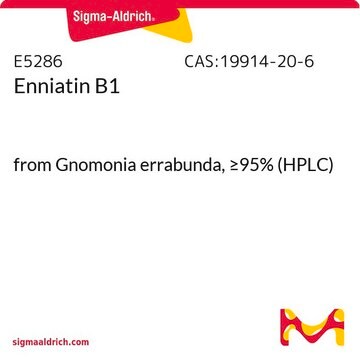32609
Sterigmatocystin
Synonym(s):
3a,12c-Dihydro-8-hydroxy-6-methoxy-7H-furol[3′,2′:4,5]furo[2,3-c]xanthen-7-one
About This Item
Recommended Products
grade
analytical standard
reference material
manufacturer/tradename
Manufactured by: Sigma-Aldrich Production GmbH, Switzerland
technique(s)
HPLC: suitable
gas chromatography (GC): suitable
application(s)
cleaning products
cosmetics
food and beverages
personal care
format
neat
storage temp.
−20°C
SMILES string
COc1cc2OC3OC=CC3c2c4Oc5cccc(O)c5C(=O)c14
InChI
1S/C18H12O6/c1-21-11-7-12-13(8-5-6-22-18(8)24-12)17-15(11)16(20)14-9(19)3-2-4-10(14)23-17/h2-8,18-19H,1H3
InChI key
UTSVPXMQSFGQTM-UHFFFAOYSA-N
Looking for similar products? Visit Product Comparison Guide
General description
Application
- Grain samples by high-performance liquid chromatography-electrospray positive ionization-tandem mass spectrometry (HPLC-ESI+-MS/MS).
- Sweet pepper samples by LC-ESI+-MS/MS.
Biochem/physiol Actions
Signal Word
Danger
Hazard Statements
Precautionary Statements
Hazard Classifications
Acute Tox. 3 Oral - Carc. 2
Storage Class Code
6.1C - Combustible acute toxic Cat.3 / toxic compounds or compounds which causing chronic effects
WGK
WGK 3
Flash Point(F)
Not applicable
Flash Point(C)
Not applicable
Personal Protective Equipment
Choose from one of the most recent versions:
Already Own This Product?
Find documentation for the products that you have recently purchased in the Document Library.
Our team of scientists has experience in all areas of research including Life Science, Material Science, Chemical Synthesis, Chromatography, Analytical and many others.
Contact Technical Service







